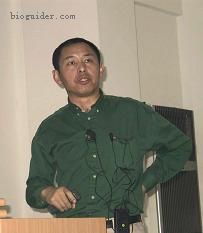上海人。74年插队到安徽。78年考到北大生物系,82年毕业并入选CUSBEA留美项目,83年赴美国“洋插队”,落户到UCLA加州大学洛山矶分校随Michael Grunstein教授学习,88年获得博士学位(酵母中的基因调控)。88年-91年在CALTEC加州理工大学Paul Sternberg教授实验室做博士后(采用线虫做发育研究)。1991年到卡罗拉多boulder执教,先后任卡罗拉多大学助理教授、副教授、教授。1997年被遴选为著名的休斯医学研究所研究员。 博士工作:韩珉教授发现了Histone组蛋白在基因转录调控和染色体分离的重要作用(发表Cell论文4篇,第一作者2篇,第二作者一篇; EMBL J论文3篇:第一作者1篇,第二作者1篇,第三作者一篇)。博士后:首先发现Ras途径在发育中的作用(在Cell等刊物发表第一作者论文4篇),独立后:所领导的研究组在细胞信号转导和发育方面有诸多重要贡献,在Cell(3), Nature(2), Science(1),Genes & Dev (6)等刊物上发表了50多篇论文并获专利2项。 1999年以来韩珉教授积极参与复旦大学的教学和科研工作,每年春季在复旦大学讲授细胞信号转导和发育课程,指导研究生,2001年与许田、庄原教授和一起在复旦大学组建了复旦大学发育生物学基地。
Summary Research Projects/Interests of Min Han's Laboratory
The Han laboratory uses Caenorhabditis elegans as a model system to study the mechanisms of cell differentiation, organ morphogenesis, and lipid metabolism.
Cell differentiation, organ morphogenesis, and lipid metabolism in C. elegans.
Due to its genetics accessibility and our knowledge of its cell lineage, anatomy, and the entire genome sequence, the nematode Caenorhabditis elegans has been a powerful model system for studying many mainstream biological problems including those closely related to human diseases. Research in our laboratory had initially focused on understanding the mechanisms controlling the development of the egg-laying organ, vulva, in the worm. However, in recently years, we have extended our effort to address interesting questions in other areas.
I. Signal Transduction in Controlling Vulval Differentiation
Cell-cell communication plays a key role in directing cells to differentiate during animal development. Vulval induction in C. elegans hermaphrodite is controlled by multiple cell signaling and regulatory pathways. Activities of a conserved RTK/RAS/MAPK signal transduction pathway induce three epidermal cells to differentiate into vulval tissues. The activity of this signal transduction pathway is antagonized by functions of so-called SynMuv genes that include genes encoding for the homologs of mammalian tumor suppressor RB. Moreover, the LIN-39HOX protein that provides the competence and specificity for vulval precursor cells.
By screening for mutations that suppress the phenotype caused by mutations of ras, researchers in our laboratory have identified many genes that encode either key factors relaying the signals from Ras, or factors positively or negatively modifying the activity of the pathway. The latter includes seven sur genes. We also collaborated with Dr. Kun-Liang Guan (Michigan) to analyze the biochemical functions of the mammalian homologs of several proteins encoded by some of these genes. Recently, we have shown by genetics that sur-6 and sur-7 are likely to act downstream of Raf to positively regulate the scaffolding protein KSR. We found that sur-7 encodes a protein that likely act as a transporter for heavy metal ions such as Zn ion. SUR-7-mediated effect may regulate the activity of KSR by phosphorylation because high Zn ion concentration causes a drastic increase of KSR phosphorylation in mammalian cells. We have also shown that the sur-9 mutation is a hyperactive allele in the C. elegans homology of human CBP tumor suppressor (CBP-1). This mutation causes a seven-fold increase in the histone acetyltransferase activity of the recombinant CBP-1 in an in vitro assay.
To further identify genes acting downstream of the signaling pathway and genes involved in the execution of vulval differentiation, we have conducted additional suppressor screens. Five new genes have been identified and cloned. Genetic and biochemical functions of these genes are being analyzed.
Grants from NIH provided support for above projects.
II. Defining synthetic interactions with specific tumor suppressor genes
Genetic redundancy by structurally related or unrelated genes is an impediment for biologists seeking to determine gene functions through genetic approaches. We have designed a screen and isolated single mutations in seven different genes that synthetically interact with a null lin-35 (homolog of the mammalian Rb tumor suppressor) mutation, which has no obvious phenotype on its own. Analysis of some of these genes has indicated that in conjunction with some of these genes, lin-35/RB regulates cell proliferation, organ morphogenesis, and larval growth/development. In addition, we have recently carried out an RNAi-mediated genome-wide synthetic screen using a daf-18 (homolog of the mammalian Pten tumor suppressor) mutation to identify genes that act with it in previously unknown biological processes. This screen uncovered more than 30 genes that may act with daf-18 for various developmental functions.
III. Cell Differentiation, Fusion, and Migration
Hypodermal cell differentiation during postembryonic development is an excellent model system to study the mechanisms of a number of basic cellular processes involved in organ morphogenesis. For example, 11 hypodermal P cells go through cell migration, fusion, and divisions to form correct patterns during larval development. In our genetic screens, we have identified a number of genes that act in those cellular processes.
Cell divisions. By characterizing mutations that disrupt vulval morphology, we have analyzed the roles of a number of genes involved in cell division and explored the links between cell cycle control and morphogenesis. For example, we have determined that the worm evl-20 gene encodes the functional homolog of human ARL-2 and acts to regulate cytoskeleton dynamics during cytokinesis and hypodermal cell movement during development.
Cell fusion and cell shape. We have identified a number of mutations that cause defects in cell fusion and cell shape formation. Through analysis of temperature sensitive mutations, we have shown that nhr-25, a nuclear receptor gene, interacts with a hox gene to regulate hypodermal P cell and seam cell fusion events. A biochemical assay suggests that NHR-25 directly binds to LIN-39HOX. We have also shown that several cog genes function to promote proper fusion events or to specify proper morphology of vulval cells. Addition cell fusion mutations are being analyzed.
Cell migration. We have also analyzed the role of RHO family small GTPases and their interacting proteins in regulating the migration of hypodermal P cells at the first larval stage. Our study suggests that RHO-1 small GTPase plays roles in both cell migration and cytokines in the same cells, while two RAC GTPases may act in parallel to RHO to regulate only the migration of these cells.
(责任编辑:泉水)
